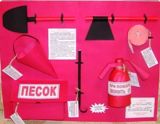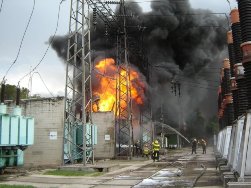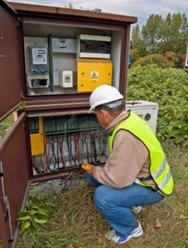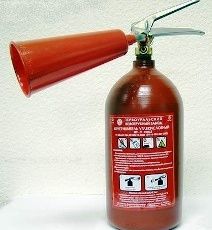Fire prevention measures during operation of electrical installations
 An analysis of fire statistics shows that about 20% of fires are caused by malfunctioning or incorrect operation of electrical installations. The incidence of fires related to electrical equipment is particularly high in residential buildings. Here, the number of fires caused by the thermal effect of electric current reaches 53% of the total number of fires.
An analysis of fire statistics shows that about 20% of fires are caused by malfunctioning or incorrect operation of electrical installations. The incidence of fires related to electrical equipment is particularly high in residential buildings. Here, the number of fires caused by the thermal effect of electric current reaches 53% of the total number of fires.
The high growth rates of the power-to-labor ratio in industry, construction, equipping apartments with electric stoves and other household electrical appliances increase the likelihood of fires due to equipment malfunction and network overload and require increased attention to the correct operation of electrical equipment.
The main causes of fires are short circuits in wires and electrical equipment (69%), leaving electrical heating installations unattended (21%), overheating due to poor contact (about 6%), overloading of electrical installations (about 3%).
Often cause of fire is a violation of fire safety rules when performing electric welding works and failure to observe fire safety distances from lamps, electric heaters, etc. to flammable materials and structures.
The persons responsible for the condition of the electrical installations, appointed by order of the head of the enterprise or workshop, are obliged to:
• ensure the timely conduct of preventive examinations and regular preventive repairs of electrical equipment and timely removal of violations of the rules for the operation of electrical installations of consumers, which can lead to fires and fires;
• monitors the correct use and selection of cables, wires, motors, lamps and other electrical equipment, depending on the class of fire- and explosion-hazardous premises and environmental conditions;
• systematically monitor and maintain in good condition protective devices against short circuit and overload and lightning protection devices;
• organizes training and instruction of electrical personnel on fire safety issues during the operation of electrical installations;
• ensure the serviceability of means of extinguishing fires in electrical installations and cable structures.
The electrician on duty (substitute electrician) is obliged to carry out routine preventive checks of electrical equipment, check the presence and operability of protective devices and take immediate measures to eliminate violations that could lead to a fire.
The main preventive fire measures for the operation of electrical installations
 When checking the electrical installations, special attention should be paid to the condition of the contacts: the presence of sparks in switches, plug connections, bolted connections, etc.
When checking the electrical installations, special attention should be paid to the condition of the contacts: the presence of sparks in switches, plug connections, bolted connections, etc.
Loose contacts inevitably cause unacceptable heating of live bolts and associated wires. If excessive heating of the contacts and wires is detected, measures should be taken to unload or shut down the unit. The restoration of the contacts (removal, tightening of the screw connections) must be carried out in compliance with the safety measures against electric shock. Keep cable ducts clean. Throwing them away, especially with combustible materials, is unacceptable.
Electric motors, lamps, wiring, distribution devices must be cleaned of combustible dust at least twice a month, and in areas with significant dust emissions — at least once a week.
During operation, it is necessary to monitor the uniform phase load of single-phase electric receivers — lighting, electric heating devices. It should be remembered that in the presence of single-phase electric receivers, a current flows through the working neutral wire, the value of which can reach the value of the phase current. Therefore, the cross-section of the neutral conductor in lighting installations with gas-discharge lamps must be equal to the cross-section of the phase conductors.
One of the causes of fires is heating when belt drives slip. When checking and repairing electrical installations, it is necessary to monitor the correct tensioning of flat and V-belts on motors and transport installations (conveyor belts, bucket elevators, etc.).The results of the inspections, the detected defects and the measures taken are recorded in the operational log.
Special care must be taken when working with a blowtorch. Must:
• fill the lamps only with the fuel for which they are intended;
• pour fuel into the lamp tank for no more than 3/4 of its capacity;
• wrap the filler plug with at least 4 threads;
• do not over-pump the lamp to avoid explosion;
• do not light the blowtorch by feeding a flammable liquid to the burner;
• stop work immediately if a malfunction of the lamp is detected (reservoir leakage, gas leakage through the burner thread, etc.);
Do not pour or pour fuel or disassemble the lamp near a fire.
 The main methods of increasing the fire safety of electrical installations are their implementation in accordance with PUE, the correct choice of protection against short circuit and overload, compliance with the requirements of the rules for the technical operation of electrical installations for load mode, repair work, etc. No overloading of wires and electrical equipment above the established norms is allowed. Load control should be done using stationary ammeters or using a current clamp.
The main methods of increasing the fire safety of electrical installations are their implementation in accordance with PUE, the correct choice of protection against short circuit and overload, compliance with the requirements of the rules for the technical operation of electrical installations for load mode, repair work, etc. No overloading of wires and electrical equipment above the established norms is allowed. Load control should be done using stationary ammeters or using a current clamp.
All electrical installations must be protected against short-circuit currents and other abnormal conditions that could lead to fire (circuit breakers, fuses, surge devices, etc.). Fuses and circuit breaker settings must match the wire size and load rating. It is not allowed to replace blown fuses with bugs and jumpers, at least temporarily.
Each panel shows the rated fuse currents and setting currents of the automatic machines on each line and calibrated fuses should be available.
All connections, terminations and branching of wires made during work are done thoroughly - by crimping, soldering, welding, bolting, etc. Hooks and twisting of wires are not allowed.
In fire-hazardous areas of industrial and warehouse premises with the presence of combustible materials (paper, cotton, linen, rubber, etc.), as well as products in combustible packaging, lamps and electrical equipment must have a closed or protected design. The presence of flammable objects and materials is unacceptable near the wires.
The construction and operation of temporary electrical networks, as a rule, is not allowed. An exception may be temporary lighting installations and electrical wires that supply the place where construction and temporary repair and installation work is carried out. Such installations must be carried out in accordance with all the requirements of the PUE.
For portable electric receivers, it is necessary to use hoses and cables. It is necessary to monitor the condition of the wires at the entry points in the box of the portable tool and in other places where friction and breakage are possible.
Portable lighting fixtures are equipped with glass covers and nets. Lighting fixtures (stationary and portable) must not come into contact with combustible building structures and combustible materials. The wires must be protected from mechanical damage.
In accordance with the rules for technical operation, it is necessary to regularly measure the insulation resistance of wires and electrical equipment. In networks with a voltage of up to 1000 V, the insulation resistance of each section of the network is at least 0.5 MΩ
In four-wire networks, it is necessary to monitor the condition of the contacts and the reliability of the insulation of the neutral wire, as well as the phase wires.
Electrical equipment must be kept in good condition, under constant supervision. The use of defective contacts, switches and other equipment is not allowed.
When working with electrical installations, it is prohibited:
• use electric motors and other electrical equipment whose surface heating during operation exceeds the ambient temperature by more than 40 ° C;
• cables and wires with damaged insulation; electric heaters without refractory supports. You should also not leave them unattended for a long time connected to the network;
• use non-standard (home-made) electric ovens or electric lamps with a filament for heating rooms;
• Leave live electrical wires and cables with bare ends.
During work stoppages (at night, weekends and holidays) all wires in fire-hazardous rooms are disconnected from the switchboard. The emergency lighting, if necessary, can remain on. If possible, it is recommended to disconnect the mains power during shutdown and in rooms with normal environment.
When using metal structures and strips for electric welding as a return ground, it is necessary to create a reliable contact of all joints by welding separate sections to each other to exclude sparks and overheating during the flow of welding current.
The use of wood as insulation in electrical structures is not allowed. When making meter shields out of wood, they should be fitted with front-wire guards, and the wire holes should be supplied with firmly fixed porcelain or plastic grommets.
Do not store flammable liquids in electrical rooms.
Coveralls should be stored in special rooms, hanging unfolded, to prevent spontaneous combustion. Do not leave oiled rags and cleaning ends in pockets. Oily cleaning material can ignite spontaneously and should be stored in metal crates. Used cleaning material must be removed daily from work areas, taking particular care not to leave cleaning materials near operating electrical equipment and in distribution cabinets and power points.
Extinguishing fires in electrical installations
 Electrical installations must have primary fire extinguishing equipment.
Electrical installations must have primary fire extinguishing equipment.
To ensure mobile deployment of fire departments, approaches to electrical equipment and entrances to electrical machine rooms and substations should not be cluttered.
Sand is used to extinguish small fires in cables, wiring and flammable liquids.Dense and asbestos cloth is thrown over the burning surface to isolate the fire and prevent air from entering.
Carbon dioxide fire extinguishers are used to extinguish live equipment and flammable liquids. The bell is aimed at the fire and the valve opens. When using a fire extinguisher, care must be taken: do not bring the funnel close to live parts and do not touch it, so as not to freeze your hands.
The use of foam fire extinguishers is only permitted when the equipment is turned off.
Carbon dioxide fire extinguishers are checked once a month. The weight of the carbon dioxide bottle is checked once every 3 months; to ensure that no carbon dioxide escapes through the valve.
The first person who notices a fire or a fire must immediately inform the fire department and the senior duty officer in the workshop or electrical equipment about it, and then start extinguishing the fire with improvised means on their own.
Connections on which the equipment is lit must be disconnected without the prior permission of the senior duty officer, but with subsequent notification.
It is impossible to extinguish a fire with water without relieving the tension (exceptions are possible in special cases, according to special instructions for fire services).
In the event of a fire, the transformer is switched off from all sides, then extinguished with sprayed water and fire extinguishers.
In the event of a fire, on the control panels and control panels, the voltage is removed from them and extinguished with fire extinguishers with carbon dioxide, sand.
In the event of a fire in the cable ducts, the voltage is removed and extinguished with a compact stream of water.At the initial stage, the burn site can be covered with sand. It is necessary to take measures to isolate the hearth in which the fire occurred from neighboring premises. Ventilation must be turned off.
It should be remembered that many polymer materials used for insulation and protective covers of cables, as well as plastics, when burned emit poisonous substances that have a suffocating effect, destructive to the lungs, blood, nervous system, etc.
Upon the arrival of the fire department, the duty senior officer of the electrical personnel instructs about the presence of adjacent live parts that remain live and gives written permission to extinguish the fire.
